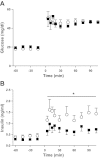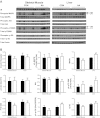Increased amino acid supply potentiates glucose-stimulated insulin secretion but does not increase β-cell mass in fetal sheep
- PMID: 23211516
- PMCID: PMC3566506
- DOI: 10.1152/ajpendo.00377.2012
Increased amino acid supply potentiates glucose-stimulated insulin secretion but does not increase β-cell mass in fetal sheep
Abstract
Amino acids and glucose acutely stimulate fetal insulin secretion. In isolated adult pancreatic islets, amino acids potentiate glucose-stimulated insulin secretion (GSIS), but whether amino acids have this same effect in the fetus is unknown. Therefore, we tested the effects of increased fetal amino acid supply on GSIS and morphology of the pancreas. We hypothesized that increasing fetal amino acid supply would potentiate GSIS. Singleton fetal sheep received a direct intravenous infusion of an amino acid mixture (AA) or saline (CON) for 10-14 days during late gestation to target a 25-50% increase in fetal branched-chain amino acids (BCAA). Early-phase GSIS increased 150% in the AA group (P < 0.01), and this difference was sustained for the duration of the hyperglycemic clamp (105 min) (P < 0.05). Glucose-potentiated arginine-stimulated insulin secretion (ASIS), pancreatic insulin content, and pancreatic glucagon content were similar between groups. β-Cell mass and area were unchanged between groups. Baseline and arginine-stimulated glucagon concentrations were increased in the AA group (P < 0.05). Pancreatic α-cell mass and area were unchanged. Fetal and pancreatic weights were similar. We conclude that a sustained increase of amino acid supply to the normally growing late-gestation fetus potentiated fetal GSIS but did not affect the morphology or insulin content of the pancreas. We speculate that increased β-cell responsiveness (insulin secretion) following increased amino acid supply may be due to increased generation of secondary messengers in the β-cell. This may be enhanced by the paracrine action of glucagon on the β-cell.
Figures








References
-
- Ahren B, Pacini G. Islet adaptation to insulin resistance: mechanisms and implications for intervention. Diabetes Obes Metab 7: 2–8, 2005 - PubMed
-
- Beckett PR, Hardin DS, Davis TA, Nguyen HV, Wray-Cahen D, Copeland KC. Spectrophometric assay for measuring branched-chain amino acid concentrations: application for measuring the sensitivity of protein metabolism to insulin. Anal Biochem 240: 48–53, 1996 - PubMed
-
- Blommaart EF, Luiken JJ, Blommaart PJ, van Woerkom GM, Meijer AJ. Phosphorylation of ribosomal protein S6 is inhibitory for autophagy in isolated rat hepatocytes. J Biol Chem 270: 2320–2326, 1995 - PubMed
-
- Boujendar S, Arany E, Hill D, Remacle C, Reusens B. Taurine supplementation of a low protein diet fed to rat dams normalizes the vascularization of the fetal endocrine pancreas. J Nutr 133: 2820–2825, 2003 - PubMed
-
- Boujendar S, Reusens B, Merezak S, Ahn MT, Arany E, Hill D, Remacle C. Taurine supplementation to a low protein diet during foetal and early postnatal life restores a normal proliferation and apoptosis of rat pancreatic islets. Diabetologia 45: 856–866, 2002 - PubMed
Publication types
MeSH terms
Substances
Grants and funding
LinkOut - more resources
Full Text Sources
Other Literature Sources
Medical

